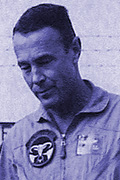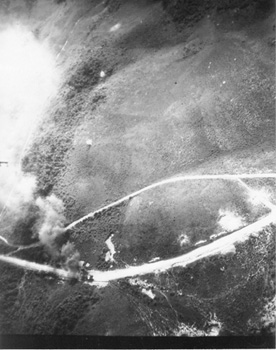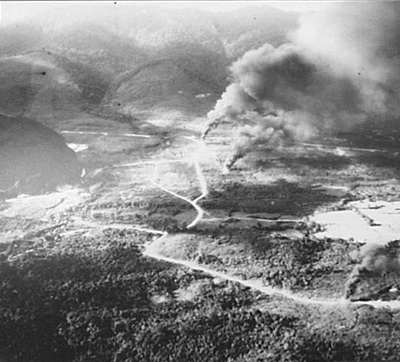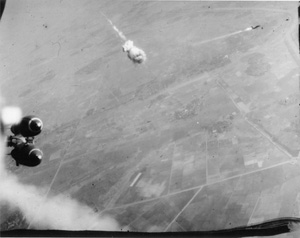Chapter 5 >
Autobiography home >
NF-104 home

|
|
|
Chapter 2 Aerial Combat |
|
Chapter 3 Flight Test |
| Chapter
4 Approach to Space |
|
Chapter 5 Limited Weapons, Assured Defeat! |
|
Chapter 6 Limited War: Unlimited Sacrifices & Defeat t/c |
|
Chapter 7 End of the Beginning t/c |
|
Chapter 5 - Limited Weapons, Assured Defeat click on the links below for more of the story... i. Limited Feedback - ii. Back to School - iii. 388 Tactical Fighter Wing - iv. Rolling Thunder - v. Rules by Fools - vi. The Bridge - vii. Good Morning Vietnam! - viii. Home Again |
|||||
The BridgeLast and Lost Doumer Mission Our next opportunity at the bridge came on 14 February 1968. I was again flying as mission commander and had only 34th squadron pilots in the attack group. Spence Armstrong flew my number 3 in the lead flight as deputy and Don Hodge led the 2nd flight, responsible for flak suppression. Dave Igleman, another of the 34th many assets, was also in our formation and his recollections are included below. After some good results on previous attacks on that bridge, and with added experience, I looked forward once more to this most challenging and stimulating of all the mission challenges. I have decided to use the words of one of the finest officers, outstanding pilots, courageous warriors and kindest 3-star generals I know, whom I selected for my element lead on this mission, such a big show! But the main reason is I like what he says about me in this, even if it convinces me that time and age have dulled his senses as well as they have his golf swing. We played once in training at Wichita and again many years later, and I can attest that both recalling facts and hitting for distance now elude him, but flinging complimentary blarney sure has not diminished. By passing on the narrative of this mission to him, I avoid explaining the unexplainable, and an urge for excuses, where I had none. If you have read this autobiography, you know that was by no means my first major screw-up. So I can take the heat, however, I protest that he brings up that my bombs missed the bridge … considering the scant margin of my miss. I assure you they were not more 50 miles short of the target, as the F-105 flies, but that’s up for debate! The fact is that I made a damned good dive bomb run when we finally reached the target, even though I may not have been concentrating as well on bomb accuracy as usual, but I did try to. I was aware of flak more than on any other mission! Here’s how Spence Armstrong remembers that mission: “The weather cleared in Pack VI A so we launched against the Hanoi Railroad and Highway Bridge (alternately called the Canal des Rapids Bridge) which I hadn’t bombed since 28 October. Bob Smith was the mission commander and I was flying #3 in the lead flight, which meant that I was the deputy mission commander. We went the water route and dropped off on a Northwesterly heading towards Hanoi in unusually clear weather. As we neared the coastline of the Red River Delta, I noted Bob’s two 3,000# bombs drop and impact with violent explosion on the beach. I called out: “Scuba lead, why don’t you turn around and I’ll take the force in”. There was absolutely no reason to risk oneself and an aircraft that had no bombs. His response was: “Negative”. I should have expected as much from hard-headed Bob Smith. He knew that I was perfectly capable of taking the force to the target but he wasn’t about to retreat. So Bob lead us in for a run on the bridge. He made his dive bomb run as if he had bombs to drop. Post strike photography showed that there were about 30 cars on the bridge when we arrived and the locomotive was valiantly trying to back off which apparently he was able to do. I released my bombs and joined up with Bob for our egress. Our #2 man, Bill Thomas and our #4 man, Gary Durkee were no where to be seen so the two of us headed to the tankers. When we coasted up to the tankers, we observed that the two of them were already there. I should mention that this was the first Pack VIA mission for both of them and that probably accounts for their actions. I called out: “Hey, #2, you’ve still got a bomb on your right wing”. Gary Durkee called: “And you’ve got one on your left wing too”. Bill apparently didn’t realize that his 3,000# bombs had not released when he hit the button. Even with this extra load, he had out run us and Gary was so mesmerized by the 6 SA-2 missile launched and the 85 mm flak which popped around us, just before roll-in, that he hadn’t noticed the bombs on Bill’s aircraft. They were justified in having adrenaline up to their eyeballs because of the enemy defenses since Capt. Bob Elliot from our squadron was hit by a SA-2 on the way out and killed. When we landed Bob Smith told us what happened to him on the way in. He was flying on auto-pilot as the mission commanders always did to give some stability to the many aircraft using him for guidance when the auto-pilot “burped” and he hurriedly grabbed the control stick. In his haste he inadvertently hit the already armed bomb release system. Explanation: There were a dozen things that one had to do before entering North Vietnam. Maybe some pilots used a checklist but I memorized the steps since I wanted to keep my head out of the cockpit. I made up a little jingle which contained the first letter of what needed to be done and had rehearsed it enough so that it came naturally even in times of extreme stress! Some of those steps were to dump the cabin pressure so that you would not ingest fumes in case of a hit in the compressor section. You also had to verify that you had selected the correct mil setting for the attack, selected the proper ordnance on the appropriate station, gone to 100% oxygen, etc. All of this time you had to maintain your formation position and look for Migs and SA-2’s. This was not easy and the less competent/current pilots had all they could handle! Bob had already done all of this and now was concentrating on positioning the force for the attack when the auto-pilot “burped”. Bob was now faced with two thoughts. The first was what to do with Bill’s bombs. Our 3,000# bombs were a precious commodity, so he was loathe to just drop them safe. Secondly, he was still smarting over the inadvertent loss of his bombs. So after we all took on our post strike fuel (Bob told us to take a couple thousand pounds more than every other flight was taking on board) Bob called for a FAC in Pack I. All of the other flights proceeded down the Gulf and headed back to Thailand across South Vietnam—except the four of us. We flew into Pack I and made contact with a FAC who said that he had spotted a building at the North end of Muy Ghia Pass where some bad guys were hanging out. It was easy to see so Bob told Bill Thomas to bomb it. Bill made his run but the bombs failed to release a second time—an obvious material malfunction. Bob then told him to do it again but this time to hit the jettison button, which caused the bombs to impact still attached to the pylon and thus not armed. This was done. Then Bob asked the FAC if he wanted us to strafe the building since we had 1,000 rounds of 20mm ammo each. Of course the FAC said yes. So Bob made the first firing pass by flying below the heights of the pass to get the right attack dive angle. We all followed and made 3 passes each until we had fired all of our ammo. I’m sure it looked to a casual observer that we doing gunnery practice on a range back in the states. In fact, Muy Ghia Pass was known to have the fiercest defenses on the Ho Chi Minh Trail. Reconnaissance aircraft transited it at 600 knots and still were shot at by the flak sites situated on the hillsides. As far as any of us could tell, they never fired a shot at us while we made these vulnerable, multiple passes. We concluded that this was such an unusually bold effort that the North Vietnamese just knew it had to be a trick! From my standpoint, I had just hung my precious bottom out twice on one mission for just one counter. This was vintage Bob Smith! He had no fear of anything.” My thanks to Spence for his fine compliments, and especially his excuse for my having dumped the weapons for which I had made the trip. It was like the cowboy in the old western knocking the gun out of his own holster just before the draw, any way I look at it. I do take umbrage with his insinuation that I might have used a checklist. I never used one in a fighter in my life, except during testing and then only on test points. I was once serioulsy chastised by one of the Air Force’s top test pilots, Col. Tom Collin’s for failing to do so on an F-104 Standard Evaluation, which just might have exacerbated a poor OER that he endorsed. I promised to relay some recollections of Dave Igleman, whose choice to discuss this particular mission out of 100, was purely his own. He was not aware that I would write on it, but he shows you what a cruel streak resides inside “Attack Pilots”, to hit a man so hard when he’s down. Dear Bob - after 35 years, my recollections of my missions are rather short, inaccurate, and mixed up together. There are snatches from several missions that I recall vividly, and then there are blurs that have been little thought of over the past 35 years. But one in particular was a bit humorous: you had appointed me the Sq. Battle Damage Assessment officer. As such, I had to review gun camera film to determine aim points, then film from various type cameras on the underside of each Thud, take "opinions" from each driver, then "score" each sortie on a "bullseye" type target sheet, using clock positions and distances, such as "2 o'clock at 50 feet." I don't recall how the data was used. Anyway, we had not been to RP VI for a while because of weather when we got the word that the target area would be clear. In the meantime, we had gotten some new pilots in the squadron, and as the strike force leader, you made several points in your briefing that the Friggen New Guys should pay attention to the old heads, and the old heads should watch out for the FNGs. As we dropped off the tankers over the gulf and headed for NVN, you called for the strike force to "green 'em up," then about 5 seconds later this little voice said "Lead, your bombs came off." It was one of the FNGs, flying as your #2. If you recall, I had to give you a score of "6 o'clock at 120 miles." I don't recall the date, target, or how well we hit the target, but I always chuckle a bit when I remember that incident. By the way, I don't think I can tell many stories without using my hands!! Dave Igelman My comment on that would generally be that I can’t respond to such an accusation without using my hands either, at least one finger, no more than two, even if I use both hands! And if Dave can no longer remember an attack on the Doumer his mentality has changed little, and with that comment I get even. My decision to continue leading the mission through the attack had nothing to do with courage but with duty, responsibility and a lot of embarrassment, since the loss of my weapons rested solely in my hands (no pun intended). I had complete confidence in Spence, which was why he flew #3 with me on that particularly important mission, should I have had to abort, but I did not, and commanding was my primary assignment. That was my most disappointing mission performance in that tour. It left that same sour memory for a lifetime that I carry from my last battle with the Mig-15s in Korea, but to a lesser degree.
As for the action in the lower route pack, we often took on extra fuel to assist in the never ceasing interdiction of supplies to the Viet Cong that passed through the lower route packs of NVN. I often found those voluntary additions to my missions, very exciting and rewarding. Cathartic, since the damage to the enemy’s efforts against our ground troops in SVN was more immediate in those than the Route Pack VI attacks. It was ‘lagniape’ as our New Orleans Cajun friends say: A little something extra .... at no charge! There were active defenses, as many learned the hard way, some of them in Thuds, but frankly, on the way home from a dive attack in Pack VIA, those seemed rather tame. We faced mostly 37’s and ZPU’s, a Russian automatic AAA gun, that was very fast tracking and effective at low altitude, but the mass of fire had no comparison with “Downtown”. However, I almost bought the farm on one such foray. A Misty FAC had two trucks sighted, which proved to be empty, heading back north, but there were low clouds. I had the flight stay clear to avoid danger of collision, with the reduced visibility and took out the first truck with my cannon. It only took a split second of fire to knock it out. Following the FAC’s directions, I spotted the other one, hard to keep in sight because of the clouds and made another low strafing pass but almost went with him. As I started the pull-out from maybe 20 feet above the tanker my K-70 got a picture just as I passed. Then I caught the first sight of a steep hill directly in my path. It was too wide to skirt and terribly ominous, because the clouds had forced me into a very slow speed pass for the Thud and I couldn’t get much turn or climb. My only choice was straight pull-up, just avoiding a stall and I suspect I was burning the leaves as I barely made it over the peak.
On another mission I got four full fuel trucks in just as many passes, before going home, but the weather was more cooperative and I got some better photos of the results. In one a lone AAA gun, probably 37mm shows the tell-tale white smoke ball from the barrel. I regretted initiating that practice for a long time, after I learned that Roger Ingvalson, one of our more adventurous pilots who practiced it with me, was shot down and made prisoner on just such a mission shortly after I returned to the States. Roger was one of our outstanding pilots and Armstrong’s replacement as operations officer. I enjoyed a big relief, when I learned what really happened. Roger, took me off the hook when he recently wrote to me about his last mission:: “My mission was to lead a flight of two to knock a bridge down in North Vietnam. We both had an air to ground missile hung under each wing. It was a fun assignment-no defenses-so I thought. We were successful, on this, my 87th mission. A Misty, F-100, forward air controller, requested that we hit an enemy convoy of trucks. Having a full load of 20 mike-mike cannon shells available, I jumped at the chance to attack and destroy the enemy. I believed in high speed, low altitude engagement to assure accuracy. I rolled in above 500 knots, waiting to below 50 feet before pulling the trigger. Surprise! Heavy defenses were in the area. Explosion! My cockpit filled with smoke immediately. I hit the afterburner to gain some valuable altitude, pulled the canopy ejection handle to get rid of some of the smoke, and shot up to about 600 feet when all hell broke loose. My aircraft went into an uncontrollable roll. The problem was that now I no longer was ascending but I was heading down. Urgent! Ignoring any ejection procedures but rather by reflex, I pulled the ejection seat handle and squeezed the trigger. That’s the last thing that I remembered until I regained consciousness just before hitting the ground. Now, I realized that I was doomed to capture. My freedom was about to go! Dozens of little brown people were racing toward me, yelling in an angry foreign tongue. As I hit the ground my first reaction was to feel for broken bones because with 15 years of experience, I was fully aware of the chance of multiple fractures in such a high- speed bailout. To my amazement I had none, not even bruises. I had spent my entire forty years of life regularly going to church. However, I was not a Christian. With my knowledge of the Bible, I knew that Jesus Christ performs miracles and there was no doubt that this was a miracle. The Lord was getting my attention so, in the middle of this dried out rice paddy and angry people getting ready to capture me, I prayed to God that Jesus Christ would take over my life. I was captured immediately but because of making the most important decision of my life I survived almost fire years of torture, starvation and loneliness as a Prisoner of War of the North Vietnamese Communists. Yes, this was the worst day of my life. I lost my freedom. However, it resulted in the best day of my life because I gained that hope and promise of eternal freedom in Heaven Returning to that last mission I flew to the Doumer Bridge, it had a very sad and costly down side that far outweighed the results of the mission, my disgust with my own results or any other aspect. That was, the loss of a very courageous young Captain, Bob Elliot, who sacrificed his life in the conduct of the mission while protecting us from attacking missiles. Bob was a fine young man and talented pianist and gave us real treats by playing for us, especially his favorite, classical music. Bob was distressed when he told me that he had received a “Dear John” from his wife, which made the event of his downing all the more disturbing for me.
No one saw Bob go down when hit by one of the SAMs he was attacking with his Wild Weasel flight, since he was the outside wingman in a turn. But, when the 70mm films were processed, one of the aircraft turning away from him just happened to catch the disaster on it’s belly-mounted strike camera, when the Weasel crew launched its own anti-radar missile. The moving prism of the camera was in position to record the weapons on it’s multiple ejection rack (MER) as well as the scene frozen in time by the smoke trails. The SAM had exploded in a puff of smoke with an upward trail the absolute clue while the lethal damage to Bob’s aircraft was self-evident from its blazing tail of fire. Bob Elliot joined that terrible Missing in Action category. More recently, I display it with a newspaper clipping sent me by our friend Don Hodge, dated December 28, 1999, which read as follows: Monty Pharmer pointed out to me that this mission was the first Strike Force flight for him and his roommate Gary Durkee and they were both pretty up tight on the drive to the flight line after briefings. Monty wrote,“I remember that Bob Elliot, Gary and I had ridden out to our airplanes together and he was telling Gary and me “Not to worry, since he knew it was our first go at Pack VI.” It seems to me that those who met such fates in WW II, and to some extent even Korea, rested in far greater peace than those souls of this ignominious war, who were forgotten by many, even before the bugles blew for them. Their honor was finally recognized with the Wall of Remembrance as tribute to the fallen of Vietnam. It will be a grand day when all the United States Air Force is honored by a memorial to all fallen heroes. The Air Force remains the only of four major services without a War Memorial in our nation’s capitol, but an organization, Air Force Memorial Foundation, is working hard to change that. The Congress has finally approved a site, but if that is to be achieved it will be by public commitment, which is proceeding well and the information and opportunity to assist is presented on their website. |
| previous sectionn | next section |



